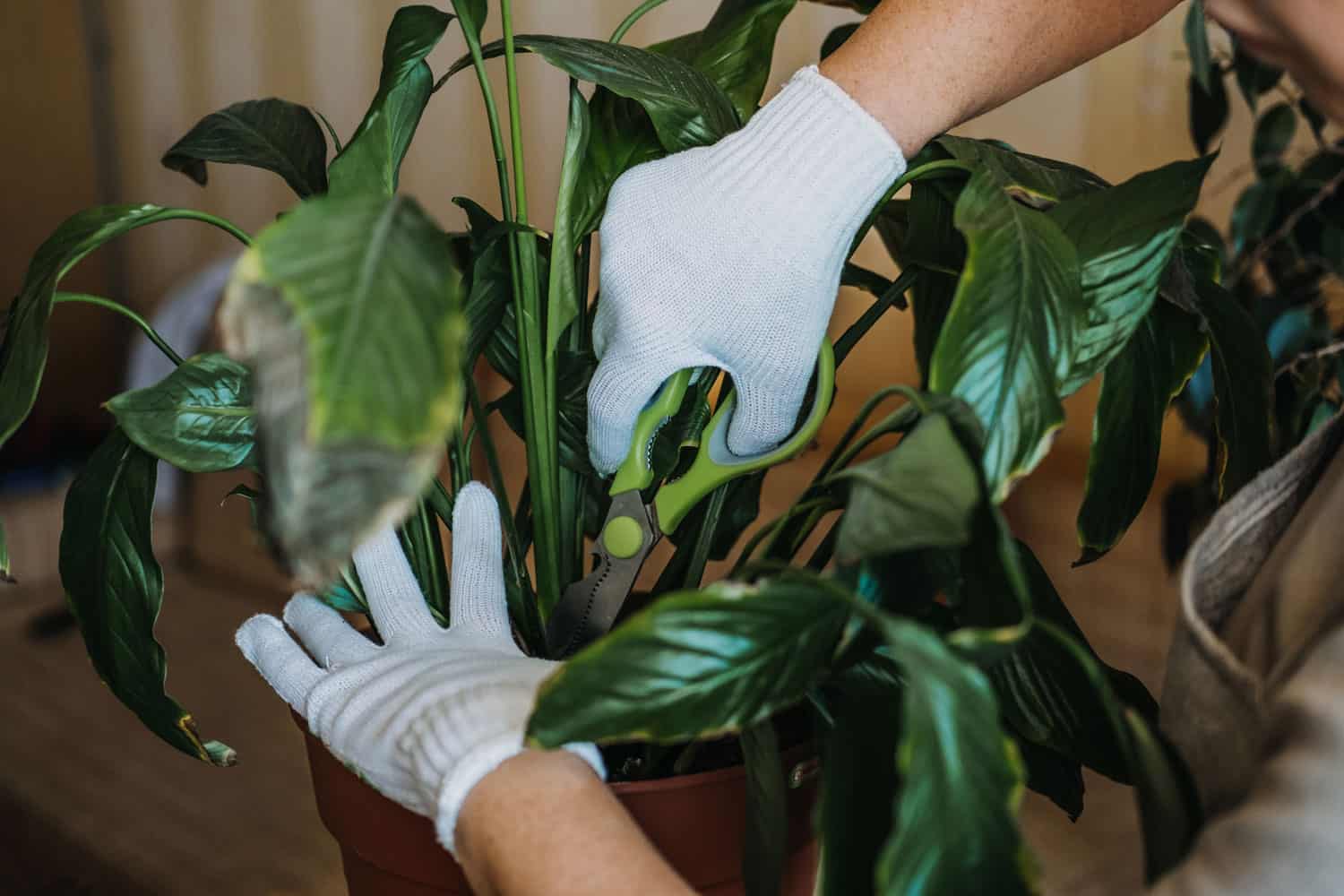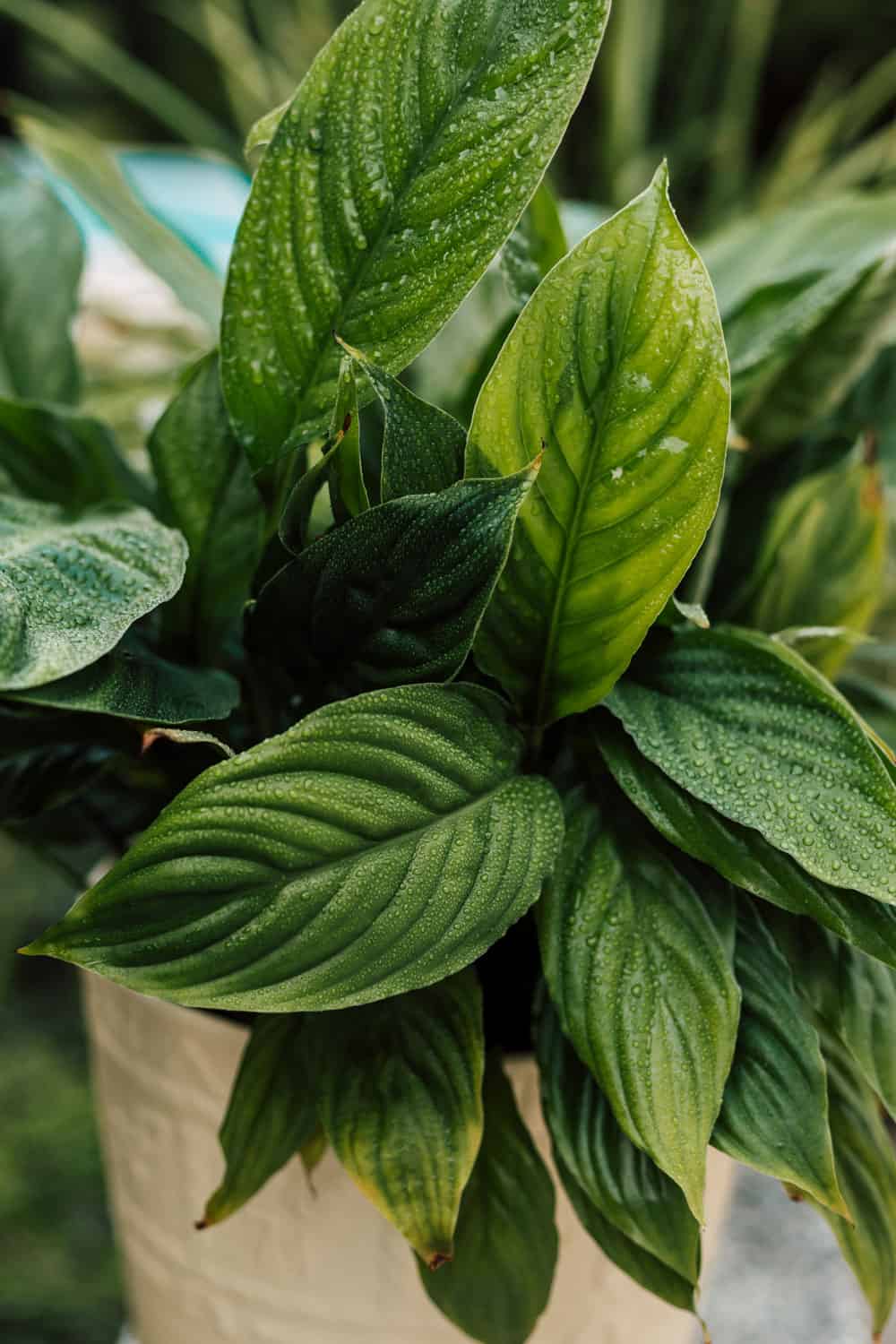Are you new to the plant game or just on the hunt for something easy to care for? Your search is over – welcome the peace lily (Spathiphyllum) into your collection!

Peace lilies are pretty incredible with their gorgeous white flowers, but let's keep it real – they can be a bit dramatic sometimes. They might throw a few problems your way, like:
- Yellow or Brown Leaves
- Drooping
- No Flowers
- Root Rot
- Mushy Stems
This article will help you solve these peace lily problems and get your plant buddy to look happy and healthy again. Stick around for straightforward, down-to-earth advice.
Understanding Peace Lily
The peace lily is known for its attractive white blooms and lush green leaves. They are easy to care for and can thrive in various indoor environments.
Peace lilies are indigenous to rainforests, typically found in the understory beneath larger trees. They have adapted to flourish in low-light conditions with limited sunlight.
1. Yellow or Brown Leaves
If you have a peace lily, you may have noticed its leaves turning yellow or brown. This is a common problem with a variety of factors:
Overwatering
Overwatering is a common issue with peace lilies.
If watered too frequently or without adequate drainage, the soil becomes waterlogged, harming the roots and potentially causing yellow leaves due to reduced nutrient uptake and root damage.
Underwatering
Conversely, insufficient watering of peace lilies leads to dry soil, causing leaf yellowing or browning, particularly at the tips and edges.
It's essential to strike a balance by watering regularly while allowing the soil to dry out slightly between waterings.
Both overwatering and underwatering disrupt the plant's ability to maintain healthy leaf and root systems, leading to these visible symptoms.
Poor lighting
Peace lilies need a precise balance of light; insufficient light is due to reduced chlorophyll and photosynthesis. Conversely, too much direct sunlight can scorch their leaves, causing color changes.
The ideal lighting for peace lilies is bright but indirect, avoiding the harsh effects of direct sunlight.
Place it near a window with sheer curtains or slightly away from the direct sun. Regular plant position adjustments may be necessary to maintain the right balance for healthy growth.
Moreover, if your peace lily has a lot of yellow or brown leaves, you may want to trim them off.
This will help the plant redirect its energy to healthier leaves. Discover essential insights on pruning dead leaves from your peace lily in our comprehensive article: Should I Cut The Dead Leaves Off My Peace Lily?
2. Drooping
Drooping is a common problem that can easily be fixed properly. Here are some of the most common causes and fixes:
Improper Watering
As mentioned, peace lilies require consistent moisture. They will start to droop if they don't get enough water.
On the other hand, overwatering can also cause drooping. If the soil is waterlogged, the roots can suffocate, and the plant will droop.
Water your peace lily when the top inch of soil feels dry. Make sure to use room-temperature water and avoid overwatering or underwatering.
Direct Sunlight
Peace lilies prefer bright, indirect light. They can become stressed and droop if exposed to too much direct sunlight.
Temperature
Peace lilies prefer temperatures between 65-80°F. If the temperature is too hot or too cold, they can droop. So, keep your peace lily in a room within its temperature requirement.
Root Bound
If your peace lily has outgrown its pot, it may become rootbound. This means the roots have no room to grow and can cause the plant to droop.
If your peace lily is root-bound, repot it into a larger pot with fresh potting soil.
Pests
Pests like spider mites and mealybugs can also cause drooping in peace lilies. Treat any pests with an appropriate insecticide or wipe down the leaves with a soapy solution.
Fertilizer Issues
Over-fertilizing or using the wrong type of fertilizer can cause drooping in peace lilies. Use a balanced fertilizer formulated explicitly for peace lilies and follow the instructions carefully.
Uncover the reasons behind your drooping Peace Lily in our article: Why Is My Peace Lily Drooping?
3. No Flowers
If your peace lily is not blooming, it can be unpleasant. But don't worry; there are ways to fix this problem.
There are a few reasons why your peace lily may not be blooming:
Lack of Light
Peace lilies need bright, indirect light to bloom. If your plant is not getting enough light, it may not produce flowers. Move your peace lily to a brighter location, but avoid direct sunlight.
Over-Fertilization
Too much fertilizer can cause your peace lily to focus on leaf growth instead of blooming. If you have been fertilizing your peace lily frequently, reduce the frequency or stop altogether for a few months.
Aging
Peace lilies may stop blooming as they age. This is a natural process and cannot be fixed.
4. Root Rot
Root rot is a fungal disease that affects the plant's roots, making them mushy and black. If left untreated, root rot can be fatal to your peace lily.
Overwatering and Poor Drainage
Root rot is caused by overwatering and poor drainage. When the soil is constantly wet, the roots of the peace lily can suffocate and begin to rot.
To fix root rot in your peace lily, take the following steps:
- Remove the plant from its pot and gently shake off excess soil.
- Trim away any mushy or black roots with sharp, sterile scissors.
- Disinfect the remaining healthy roots with a fungicide solution to kill pathogens completely.
- Report your peace lily in a new container with fresh, well-draining soil.
- Only water the topsoil when it is dry.
5. Mushy Stems
If your Peace Lily's stems are soft, drooping, and mushy, it's a severe problem that needs to be addressed as soon as possible!
Like root rot, peace lilies often fall victim to the same culprits – overwatering and insufficient pot drainage.
The solution? Pause the watering routine until the soil dries out; consider repotting into a container equipped with drainage holes and fresh soil. Say goodbye to those mushy stems, and make sure your plant basks in the right light.

Wrapping Up
Peace Lilies are beautiful and easy-to-care-for plants, but they can still experience some problems. Remember to monitor your plant's watering, lighting, and humidity levels.
Act promptly at the first sign of trouble with your peace lily, such as wilting, yellowing leaves, or pest infestations. As you follow these fixes and address any problems promptly, you can keep your Peace Lily looking healthy and vibrant.
